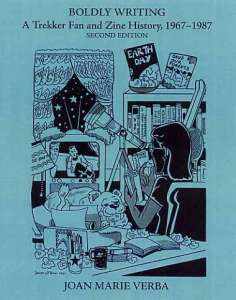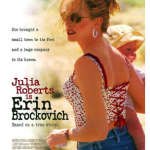March 20, 2014 | Posted in CULTURE & HISTORY, FAN FICTION | By from the archives
A historical perspective on Feedback
By Laura Hale
This essay was originally published May 2005 at FanHistory.com.
Feedback. It seems like these days that almost everyone wants it. They can never get enough of it. Authors never seem to get the amount that they want. Sometimes, the way people talk, the impression has been given, that this has always been the case with the fan fiction community. If you take a look at the history of feedback in the fan fiction community, it becomes clear that this just is not so. Feedback patterns have differed over time. A variety of things have changed over time. So what exactly was going on then with feedback?
During the period from 1967 to 1990, most fan fiction was distributed in fanzines. You could get your Star Trek, Star Wars, Doctor Who, Man from UNCLE, Duran Duran, Phantom of the Opera, Dark Shadows fan fiction in this format. If that did not work for you, other fan fiction communities were around. Stories and poems were published in fanzines for fan clubs. Stories from various fandoms were compiled in multifandom zines. Some stories were novel length and were published as stand alone zines. If you wanted to know what was worth buying or reading, there were review zines or reviews included in fanzines. There were zines with just letters from readers. The variety of zine types was rather large. According to sources on Usenet back in the mid 1990s and based on a reading of Verba, the impression was that the average fanzine might have a distribution of one hundred to five hundred copies.
The writing process for your average fan fiction writer seems to have differed from what authors currently do today. According to several acquaintances who were writing at the time and readings from Verba and Jenkins, fan fiction writing was often done by hand or using typewriters. Authors would get together at conventions and discuss their writing, holding mini workshops, do editing, discuss characterization and world building. Authors would form small writing groups near their home, where they would all get together, hang out and just write while being in the same physical space.
During this zine based fan fiction period, feedback was not the driving force of writing and publishing fan fiction. According to the same sources cited above, an author might expect one to ten pieces of reader comments snail mailed to them in the period of after their story was published. These one to ten pieces might arrive anywhere from one month to five years after the story was published. In most cases though, an author would be considered lucky to receive any feedback sent to them via snail mail. Many authors received no feedback from readers of fanzines. Public discourse, public reviews of stories and fanzines happened. This type of commenting was not feedback intended for authors. They were very clearly reviews; the intended audience was readers. These reviews would appear in letterzines, in review zines. The quality of stories and fanzines would be discussed at conventions and in fan writing groups. An author might never see those reviews of their work; they might never hear about fan discussion of their work.
People planning to do more than share their stories through single copy hand distribution had to go through the process of having their story published in a fanzine. During this period, authors were a little bit more tolerant in some cases of making changes to their story if they wanted it to be published in certain fanzines. They understood there was an editing process. This also helped to keep a certain level of quality present in fanzines or at least offered the illusion that quality controls were present. As time passed though, the further into the 1980s the community went, according to Langley and Verba, the ability to publish a fanzine became more accessible to the masses. They could print their own fanzines and as the secrets of publishing a zine were passed on to people in other fan fiction communities, the perception of quality dropped. This perception correlated with the decline of publishers taking an active process in editing zines.
The practice of reviews and recs during the zine based fan fiction community period led to the formation of two camps who disagreed on the approach to reviewing and reccing. One camp was headed by Paula Smith who said that fan fiction was valid as any other genre of criticism and thus, negative comments and critical discussion of a story were acceptable. This type of critique could and should be published in letterzines and reviewzines. The other camp said that people wrote fan fiction for fun. As such, making negative or critical comments was not acceptable and that letterzines and review zines should only say positive things about the zine and story or they should say nothing at all. An author may not ever see these reviews and they were not necessarily intended for the author. The intended audience was very clearly the larger fan fiction community to know if they should spend their money on it.
By 1985, the Internet revolution began to happen. People were publishing their stories to Usenet, to VAX, to message boards and mailing lists. Stories were being distributed over university networks. Discussions of fan fiction took place on these electronic places and in other electronic places like GEnie. Usenet and wider access to these electronic communication tools would not really begin to catch on big time until 1992 or so. Various discussions on Usenet at the time and from discussions with people who were around and using the electronic medium indicate that there was a perception of a high quality of fan fiction written during this period. There was also the perception of higher rates of feedback, unprecedented when compared to feedback received from fanzines. An estimate from a Usenet source suggested that for every ten times a story was read, a person might expect one piece of feedback, feedback that was directly targeting the author. Discussions, or waxing poetic on times long gone, suggest that these comments, this feedback, was more critical than the feedback contemporary authors receive today. It was given because there was the assumption in the fan fiction community that was present on-line that authors had a certain skill level, a certain amount of money, had access to a certain level of tech, a higher degree of education and had been around in the fan fiction community long enough to know better. A reader could engage in a little harsh critiquing. They could call an author out for spelling errors, Mary Sues and characterization. This type of attitude might explain why a Star Trek fan fiction author in 1990 could comment on Usenet and wonder where Mary Sue was. This “golden era” of high rates of feedback and higher rates of critical feedback from strangers would last from roughly 1984 to 1995.
But things change. By 1996 and continuing on into 1998, mailing lists and Usenet groups had become more accessible to greater amounts of people. The material had become easier to access on-line. The fan fiction community’s population age started to decline as younger and younger writers became involved. As this trend happened, the amount of feedback began to decline, possibly in correlation to increased fan fiction posting volume. An author writing at the time said that fan fiction authors could roughly expect one piece of feedback for every thirty times their story was read. There was also a perception in the fan fiction community at the time that the quality of feedback had declined. The fan fiction community was, at this time, still working under the assumption that this material was directed at the author. There was no confusion about what was feedback and who it was aimed at. But the state of flux was present. Younger writers and newer writers who had never been part of the fan fiction community before were involved in the fan fiction community and these neophytes were just not as tolerant of harsh crit as the authors who had been involved with fan fiction for years were.
By 1999, estimates by some authors suggest that an author might expect one piece of feedback for every one hundred times their story was read. By this time, reccing started to take off on a much larger scale. Rec comments were generally filled with praise but this praise was not directed at the author. Recs were being posted to web pages dedicated solely to recs. These were not archives but dedicated pages. This practice helped readers find well written fan fiction but it did not seem to help an author in terms of receiving a greater volume of feedback or receiving more critical comments regarding their writing. In some cases, being recced seemed to work against an author. Readers became more nervous about sending feedback with any sort of criticism, implied or not, because they feared peer pressure or being outted for having flamed the author for giving anything but glowing praise. Anon flaming was on the rise during this same period. The quality of feedback had begun a massive decline as things like AOL, Prodigy and more universities getting on-line had blown open the door and anyone and their neighbour could now get on-line easily. The media had begun to pay more attention to fan fiction and this was giving more people knowledge of the community and thus giving them ins to it. The things that were exacerbating the decline in feedback quality in 1998 were becoming worse by 1999 and 2000.
Since 1998, with the advent of FanFiction.Net, reviews had been used in the same way as feedback. It really wasn’t until 2001 that others had caught on to this; other sites and many members of the fan fiction community had started to use the two words, review and feedback, synonymously. This interchangeable usage of two words had not been done before on the fan fiction community. The result was to cause confusion and led the whole feedbacking process to be in a weird state of flux. It would never get back to a period where there was a clear differentiation between the two spaces of reviews are for readers to know if they should read and spend money on a piece of fan fiction, and feedback was for writers, to help them improve their craft and know what readers thought of their contribution.
The period around 2001 featured some other defining characteristics in terms of feedback in the fan fiction community. Some estimates by members of the fan fiction community, guessing based on their own reading habits, counters, mailing list member totals, put an author getting one piece of feedback for every two hundred to three hundred times their story was read. During this same period, the volume of fan fiction increased in some fandoms beyond a reader’s ability to read. A reader could no longer have their finger on the pulse of what was happening, reading a decent amount of the material to know what was going on, to get a broader view of what was happening.
Fandom, which on-line had become fairly centralized, had begun to fragment. Anyone could create his or her own mailing list. Scripts like efiction enabled a person to create their own automated archive with very little knowledge. LiveJournal and blogs allowed for posting in your own personalised fanspace, choosing who was welcome and not. This fragmentation happened at the same time that the fan fiction explosion was going on. It made for an even messier situation. Now, in addition to the question of were feedback and reviews the same thing, how are they different and how should a person give feedback, there was the additional pressures of how does a person navigate these new electronic mediums, what are the new standards, what are the new expectations and how does a person give feedback and what sort of feedback does a person give in these spaces. Some of this was answered with an increase in flaming, partly to blame by the increased anonymity allowed for on the Internet and partly the result of the size of a fan fiction community which allowed for less social responsibility. Flaming reached its zenith.
By 2001, the lament of lack of constructive feedback, or feedback with educational implications, had started to become bigger, louder and more annoying. It was harder and harder to tune out. It was obvious that there were a lot of authors out there that were not happy with the quality of feedback they were getting. This was an uncomfortable moment for many readers. It seemed like writers were demanding an obligation on the part of readers unheard of before. Some tried and succeed and made fan fiction writers happy. Their ability to give constructive feedback to authors they had no previous relationships with led to friendships, finding beta readers, helping change attitudes. On the other hand, some authors who demanded constructive criticism and got it were often visceral in their responses to readers. They were nasty and mean. This turned off a number of readers to the whole process. The general impression left with many readers was that authors might say they want it but they do not necessarily tell the truth to the readers and to themselves.
2004 rolled around. By this time, the flaming of authors in an author’s personal space had begun to die off. This flaming and moved to collective fan space, at sites, LiveJournal communities or on mailing lists like Bad Buffy, Citizens Against Bad Slash, Wicked X Witches, GAFF, FanFicRants, and The Mary Sue Report. The comments, critiques and rants posted to these places were clearly not intended for the author. Some of these comments were harsh, very harsh. In a few cases, there would be clear attacks on an author’s personal life in an effort to rationalize why they could not write any better or not write to suit the reader’s desires. Negative experiences on the part of readers in interacting with authors continued to scare off readers from feedbacking stories. Many readers simply refused to give feedback to an author unless they had developed a relationship with that author before that or they had been told, through friends and acquaintances, what to expect from the author if the reader gave the author unsolicited feedback. Perception wise, this seemed to indicate that if an author was posting at a larger archive or on a larger mailing list, the story was getting read more and more often but the author was receiving less per story feedback than they would have received three years prior. Some authors and readers seemed to be alienating parts of the fan fiction community by creating a fan fiction community world view that if an author published a story, they were wanting to interact with the reader. In fact, the attitude was retroactive: if an author published a story in 1996, when the fan fiction community was in a much different state, that author was demanding the same interaction that was now applicable in the current fan fiction community. This attitude differs markedly from the feedbacking processes of the late 1960s, 1970s, 1980s and most of the 1990s. Posting a story was no longer considered the same as publishing a story. Attitudes had clearly changed.
Where the state of feedback goes from here is an interesting question. Watching how things change will be enlightening. What is going to happen, that I do not know but wish I did.
Related posts at Spacial Anomaly
from the archives
"from the archives" is our Spacial Anomaly account for guest blogger posts, as well as for sharing and re-publishing of articles on fandom and fan history which are no longer available elsewhere online. Such articles are published here on Spacial Anomaly with full permission of their original authors. Please contact us if you are interested in submitting a guest post, or have any writings on fandom history, culture and meta you would like to see archived at Spacial Anomaly. Better still, consider joining our writing staff directly!
Leave a Reply
*














Be the first to comment.